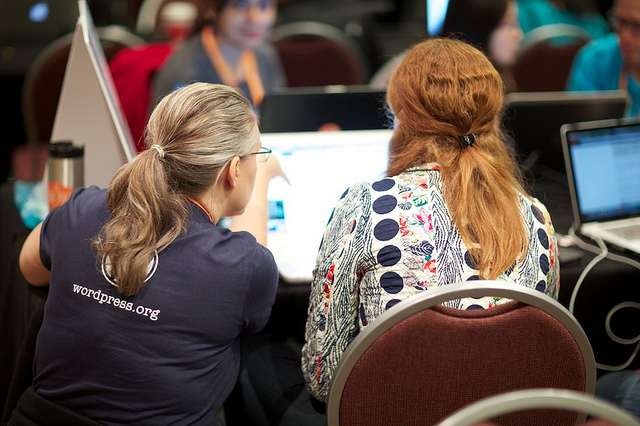
Image Credit: AnitaB.org
So here’s a question for you negotiator: just exactly what is a mutually beneficial agreement? Sure, we all think that we’d like to be able to use our negotiation styles and negotiating techniques to reach one of these in our next negotiation, but would we recognize it if we saw it? One way to define this is to view a mutually beneficial agreement as being one in which each side grabs as much as it can from a finite pot of resources. Hopefully you don’t view it this way. A much better way to view it is as competitive value-claiming with collaborative value creation. Now the big question becomes just exactly how to go about doing this.
The Power Of Mutually Beneficial Agreements
The reason that we should be looking for a way to create value at the negotiating table is not because it’s the “nice” thing to do, but because it’s been proven to be the best path to a truly mutually beneficial agreement. One of the reasons that negotiators often fail to reach a mutually beneficial agreement is because they bring a win-lose mindset to the negotiation table. It is true that in a small number of deals and disputes, negotiators have no choice but to haggle over just one issue, and that is usually price. However, in most business negotiations many more issues beyond price are involved. When negotiating a purchasing deal, for example, you and the other side might talk about not only price, but also delivery, service, financing, possible future business deals, performance bonuses, and so on. Clearly there is a lot on the table to talk about.
The one thing that you don’t want to do as a negotiator is to make the mistake of viewing complexity as being a liability in a negotiation. It turns out, somewhat surprisingly, that the exact opposite is true. You can find yourself in a good position when there is more than one thing to be negotiated. When multiple issues are on the negotiation table, this will provide you with the ability to brainstorm mutually beneficial tradeoffs with the other side. The power here is that through tradeoffs, you can achieve more than you would have if you had simply compromised on each issue. In the process, you increase your odds of reaching a mutually beneficial agreement.
As an example of what a negotiation in which a mutually beneficial agreement could be reached, think of a negotiation in which getting a supplier to deliver to you what you need when you need it is critical to you. In this type of contract, financing terms may be of less importance to you. You’ll find yourself working the details regarding deliveries, dates, and quantities while at the same time offering the other side financing terms that they can live with. In this type of negotiation, you will still need to work to claim value on each issue that is being negotiated; however, you need to realize that you have expanded what was being negotiated from when the discussions started.
How To Create Value At The Negotiating Table
As negotiators we are faced with a fundamental problem: how can we create value at the negotiating table? The reason that we want to do this is because it will provide us with a path that will allow us to get to a mutually beneficial agreement? It turns out that the first step in this process is to share information with the other side. Negotiators often fear they will give away too much if they express their true preferences on various issues. What we need to understand is that expressing preferences isn’t the same as giving away your bottom line. If you had an issue with the last deal that you negotiated as it was being implemented, this is something that you’ll want to bring up during your current negotiations in order to ensure that the same situation is not repeated.
In order to make progress towards reaching a mutually beneficial agreement, you are going to have to take on the responsibility of asking questions of the other side. For some negotiators, this can be a difficult thing to do. It’s hard because they tend to view a negotiation as simply being an opportunity to persuade the other side to do what you want them to do. If you allow this to be your mindset, then you will be so focused on your talking points that you won’t listen closely enough to what the other side has to say. However, if you listen actively and ask lots of questions then this will help you collect the information you need to develop a mutually beneficial agreement.
If you really want a mutually beneficial agreement then you are going to have to change your negotiating style. You are going to have to learn how to make multiple equivalent simultaneous offers (MESO). As negotiators, we all tend to present one offer at a time. If the offer that we’ve made is rejected, we learn very little new information that would help us to move forward. A better approach is to craft three offers that are different across issues but equally appealing to you. The other party may reject all three of the offers, but is likely to communicate which one they like the best—and this will put you back on a track toward a mutually beneficial agreement.
What All Of This Means For You
In every principled negotiation that we participate in, we’d all like to be able to walk away from the negotiations with as much as we could get. However, it turns out that it actually makes more sense to engage in some competitive value-claiming with collaborative value creation. The trick is understand how to go about doing this.
It can be hard to achieve collaborative value creation at the negotiating table if we bring a win-lose mindset to the negotiation table. We need to understand that if we are going to be able to reach the deal that we want, then we are going to have to be willing to negotiate a number of different items all at the same time. This will introduce additional complexity into the negotiations, but we need to view that as an advantage, not a disadvantage. In order to create a mutually beneficial agreement we need to start things off by sharing information with the other side. This is not the same thing as giving away too much information. Next you are going to have to get good at asking questions. This helps you to collect the information that you’ll need to create a good deal. Finally, you need to modify your negotiating style and start to offer the other side multiple equivalent simultaneous offers (MESO). By doing this you’ll be able to learn what they are looking for based on which of your multiple offers they accept and which ones they reject.
All negotiators know that creating a mutually beneficial agreement with the other side means that the chances of the deal being honored by both sides has been increased. However, it’s not an easy thing to do. However, if we are willing to take the time to find out what the other side really wants to get out of this negotiation, then we’ll be that much closer to creating a deal that both sides can live with. Take your time in your next negotiation and you just might be able to walk away with a mutually beneficial agreement.
– Dr. Jim Anderson
Blue Elephant Consulting –
Your Source For Real World Negotiating Skills™
Question For You: What’s the best way to keep track of how the other side has responded to the multiple offers that you have made to them?
![]() Click here to get automatic updates when The Accidental Negotiator Blog is updated.
Click here to get automatic updates when The Accidental Negotiator Blog is updated.
P.S.: Free subscriptions to The Accidental Negotiator Newsletter are now available. Learn what you need to know to do the job. Subscribe now: Click Here!
What We’ll Be Talking About Next Time
As negotiators we all understand that one of the most powerful tools that we have are concessions. However, it’s how we view concessions that really matters. All too often a negotiator can come to view concessions as being a big deal – they are something that has value to us and making a concession that really means something is going to end up costing us something in terms of money, time, or something else. However, this is where we may be wrong. It turns out that we can often keep a negotiation moving along simply by making a token concession. This type of concession costs us very little, but it can make a big impact on our negotiation.

